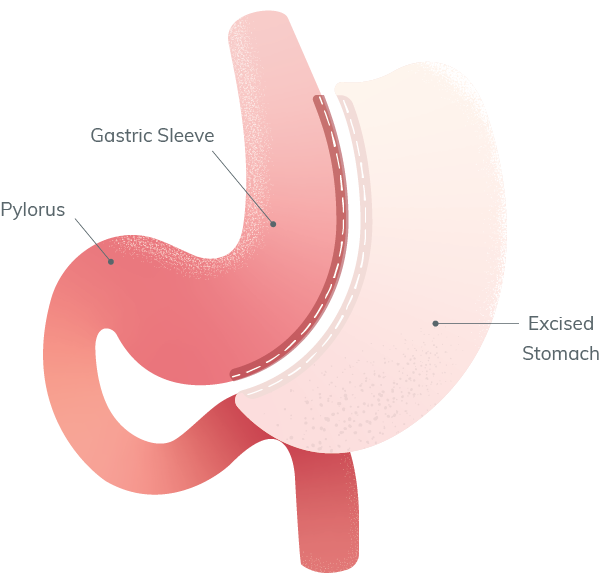The surgical route: gastric bypass and sleeve operations
Our range of metabolic and bariatric surgical procedures all have the same goal: to leave you with a smaller stomach pouch. This provides a feeling of fullness and switches off the intense need to eat, freeing up your brain.
At Tailor Clinics, your gastric bypass or gastric sleeve operations are just one aspect of the care you’ll receive. Our multidisciplinary approach is aimed at helping you reclaim your life and achieve long-term fat loss success.
Find out more about our surgical procedures below.
Laparoscopic Roux-En-Y Gastric Bypass (REYGB)
The Roux-en-Y gastric bypass procedure is usually performed laparoscopically (i.e. keyhole surgery) by our surgeons. In some cases it may be necessary to perform an open procedure through a large cut in the abdomen, however this is usually only the case if you have had an open operation before. The REY bypass operation has proven to be an effective, consistent way of losing weight and keeping it off, but achieving these results also requires lifelong changes to lifestyle and eating.
A small stomach pouch is created, restricting the amount of food that can be eaten initially. Long term, the operation also works by switching off the desire to eat. Initial weight loss at one year post-op of 87% of excess weight is the average in our practice. Patients generally spend two nights in hospital.
laparoscopic One anastomosis - loop (Mini) Gastric Bypass
The one anastomosis or loop (mini) gastric bypass operation is a simplified version of the standard gastric bypass operation, requiring only one connection. The surgery uses a combination of techniques that reduce the size of the stomach and alter hormones involved in appetite control. The advantage of the loop bypass is that the single join results in a shorter operating time and fewer potential complications. Long term, the loop bypass results in fewer intestinal obstruction problems and less risk for internal herniation.
One disadvantage is a greater likelihood of bile reflux in comparison to a REY gastric bypass, which can adversely affect quality of life. However, this is rare. Another is a slightly greater likelihood of developing significant vitamin and micronutrient deficiencies over time however this can be managed by adequate vitamin supplementation. The standard risks and complications that apply to a REY gastric bypass also apply to the loop bypass (such as dumping).
A loop bypass typically has similar results: 87% of excess weight lost at one year post-op. The most rapid weight loss occurs in the first six months after surgery and then continues at a slower pace for up to another 18 months.
Laparoscopic Sleeve Gastrectomy
The sleeve gastrectomy, a common gastric sleeve operation, was originally developed as the first stage of a two stage malabsorptive procedure in high-risk patients. Surgeons found that if they removed three-quarters of the stomach, left the patients to lose weight, then came back and finished the operation, the death rate was much lower. However, some patients did quite well even without the second procedure, although the majority did have some weight regain long term.
In this operation, two thirds of the stomach is removed laparoscopically. This severely restricts intake for the first year. Because there are no joins, it seems safer than a bypass, but still has a complication rate from leaks and bleeding. People can develop troublesome reflux for prolonged periods after the sleeve procedure. Weight loss after a year averages about 70-80 % of excess weight, but there is a tendency to regain weight after this. Patients are in hospital for two to three days. This option is offered when the other two procedures may not be suitable.




